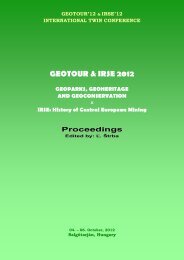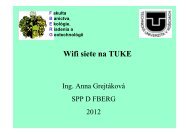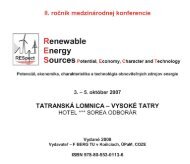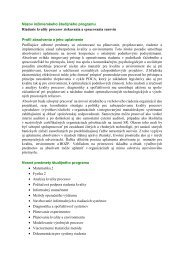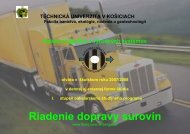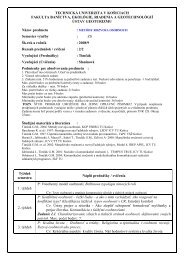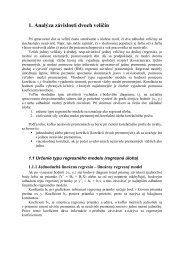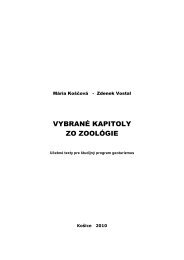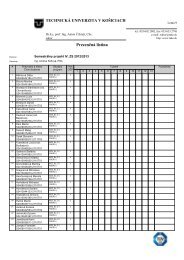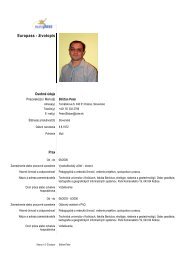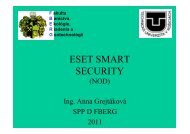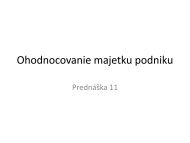GEOTOUR & IRSE 2012.pdf - Fakulta BERG - TUKE
GEOTOUR & IRSE 2012.pdf - Fakulta BERG - TUKE
GEOTOUR & IRSE 2012.pdf - Fakulta BERG - TUKE
Create successful ePaper yourself
Turn your PDF publications into a flip-book with our unique Google optimized e-Paper software.
<strong>GEOTOUR</strong> & <strong>IRSE</strong> 2012<br />
substantial benefits, on condition that such projects are accompanied by promotion activities<br />
of the local and regional authorities.<br />
b/environment and landscape perspective<br />
Attractiveness of a given region, which comprises post-mining structures arises from a<br />
number of factors to start from environmental, educational, sport, social to economic. The<br />
region may attract prospective investors, who want to restore usability of the existing<br />
structures and which may be of significance to development of a commune or even a number<br />
of communes. Evaluating attractiveness of mining excavations and their specific character<br />
should be taken into consideration when choosing an optimal direction of adaptation works. It<br />
does not mean that structures, which appear attractive due to its geological properties should<br />
be subject to protection, which will ensure preservation of their geological landscape values.<br />
Taking into account close surrounding of post-mining structures, comprehensive actions<br />
which allow scientific, research, educational and tourist approach, should be brought to<br />
attention. Such approach may be assumed in case of multi-level excavations of complex cubic<br />
capacity and variable geological structure.<br />
Existing greenery observed on excavations is also of big significance when decisions<br />
concerning adaptation projects are being made. Sometimes, as the case may be, the areas<br />
comprise very rare and vanishing or protected species, which are listed or attached to EU<br />
directives, applicable under Natura 2000 Network. Such approach means linking e.g.<br />
technical routes with nature routes, which present various flora and fauna species.<br />
There is no doubt that projects aiming to revitalise post-industrial structures, including postmining<br />
facilities, initiate significant changes as far as natural environment and site<br />
development is concerned. The said changes include, in particular:<br />
Reasonable use of resources and protection of the natural environment,<br />
Improved site development of degraded areas,<br />
Eliminating risks for people and animals,<br />
Site Development achieved through implementation of new investment projects.<br />
One of the main outcomes of such projects is restoration and protection of balance in the<br />
natural environment within the area subject to protection works, which has been affected due<br />
to years of mining and processing activity, as well as later removal of household waste into<br />
excavations. Such outcome is achieved due to execution of the planned revitalization projects,<br />
which restore balance between the man, components of nature and inanimate components of<br />
the surrounding.<br />
c/ cultural and social perspective<br />
Growing branch of industrial tourism may facilitate the process, whereby local communities<br />
identify with a cultural heritage of their region. It reflects local traditions and customs, which<br />
can be easily distinguished and identified. Contrary to some opinions which assume collapse<br />
of a concept of private homeland [German concept of “Heimat”], the idea of local community<br />
experiences a visible come back. During uncertain and turbulent times, individuals need to<br />
underline cultural unity, stability and safety, which may be offered by local community and<br />
areas occupied by its residents. This conclusion is reflected through the so called concept of<br />
“discovering tradition”. Examples of such forms of restoring elements of local life include<br />
fraternities of knights, history of which dates back to mid 70s of 20 th century, when the first<br />
knights tournaments were organised in a castle located in Golub-Dobrzyń. Currently hundreds<br />
of fraternities operating within the so called Knights Movement bring closed history of the<br />
middle ages, stage historical events, conducts educational projects. A similar situation is<br />
observed in relation to revitalization of post-mining facilities, which together with restoration<br />
127



